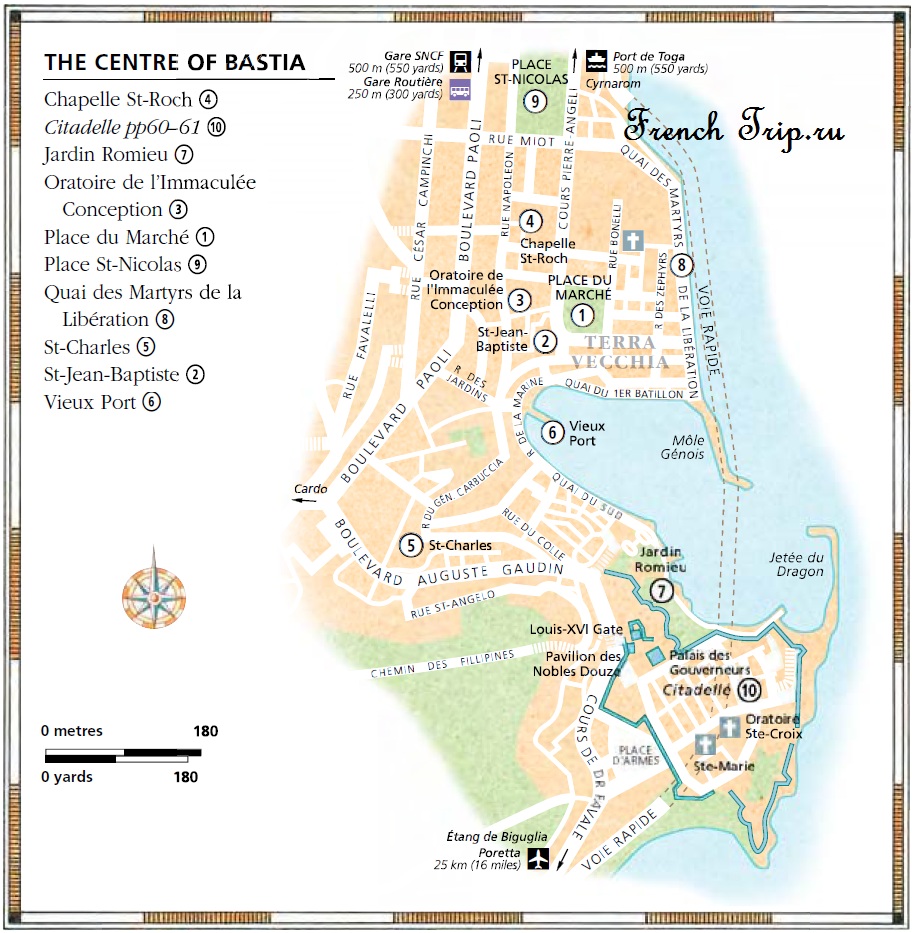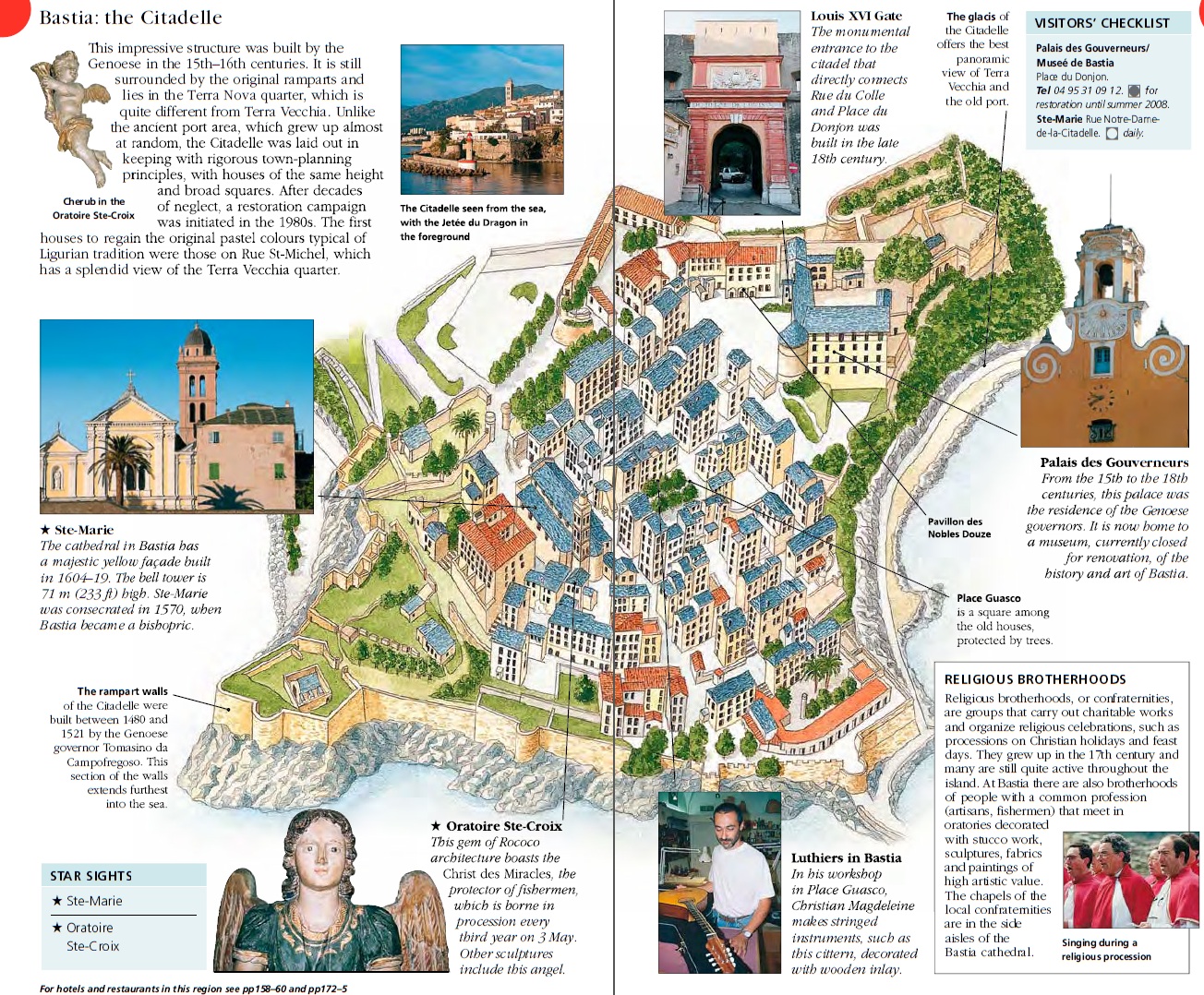Bastia main sights
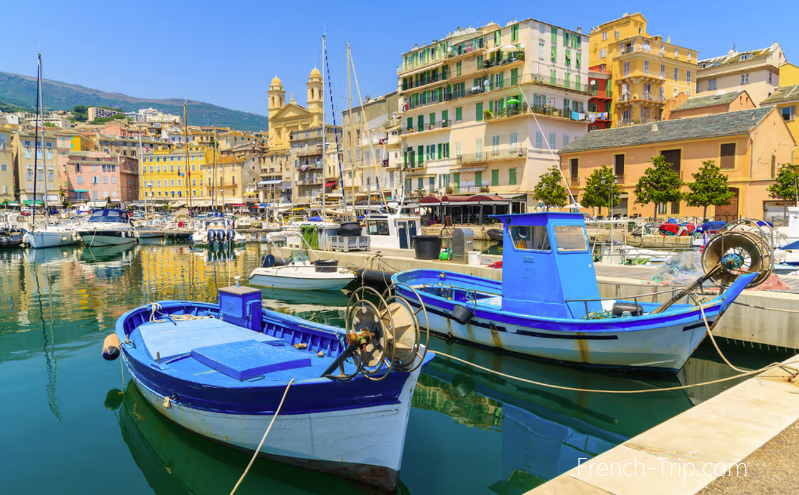
Bastia’s main sights include baroque oratories, majestic churches, the Old Port, and of course, the Citadel, proudly perched on its rocky promontory. The city, known as Ville d’Art et d’Histoire, is a place of art and history that blends mystery, timelessness, modernity, and creativity into a rich tapestry of diversity.
But beyond the gilded façades, the stones, and the palaces, what secrets does Bastia truly hold?
To uncover this intriguing question, which even many Corsicans ponder, simply stroll through its ancient center. The soul of Bastia reveals itself best through the life of its streets and encounters with its residents. To discover authentic Bastia, take a leisurely walk through the narrow alleys of Terra Vecchia, savor Corsican specialties and products at local markets or souvenirs stores, and explore local legends and traditions through unique tours.

Personal Experiences in Bastia
For us, Bastia was the gateway to Corsica and the final stop on our island journey. Despite the breathtaking beauty we had already encountered, Bastia captivated me. I have a fondness for historic towns where every building tells a story, and Bastia perfectly blends historical charm (the old citadel and port), its unique character (those weathered façades with exposed pipes), and French allure (sitting on a hotel balcony decorated with Toile de Jouy wallpaper, draped with geraniums, while enjoying delicious croissants and watching the lively street below).
Bastia has a complex and contradictory character, and it will surely leave a different impression on everyone. But it is undoubtedly a city that deserves to be savored.
Bastia tourist map:
Main attractions of Bastia
Bastia has an old port with a citadel and a historic center on the hill above the port (Bastia Old Town), and 19th-century boulevards and squares to the north of the port (Bastia New Town). These are roughly the areas along which you will explore the city.
Bastia Old Town
Bastia Port, Old Town and Citadel:
The Old Port (Vieux Port) located in the south of the city is the best place to start your visit. Here you can stroll along the harbor, admiring the densely packed houses, almost reminiscent of Venice, clustered around the fishing and tourist port. There are many restaurants around the harbor, so this can be a pleasant option for a lunch break.
To the north of here is the new commercial port, which is now used for industrial and commercial passenger ferries, leaving the old port for smaller vessels only.
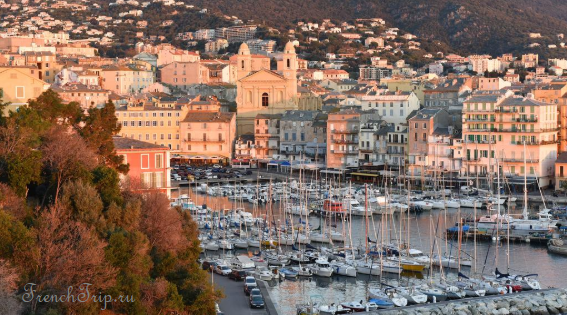
Bastia Citadel
On the south side of the harbour you can walk through the Romieu Garden to reach the citadel, which sits above the port. This is the original Genoese fortress, surrounded by defensive walls that were added in the 15th century, including the Port Louis XVI, through which you enter the citadel. It contains most of the interesting historical monuments in Bastia.
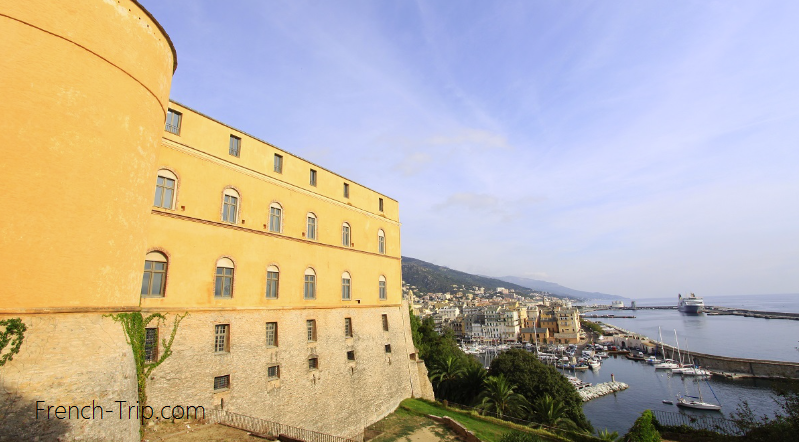
Palais des Gouverneurs
Soon after, the Governors’ Palace was added, built against a tower that is one of the oldest parts of the citadel. The original palace was rebuilt in the following centuries, and by the 16th century it had become the majestic building we see today beneath the citadel walls. The palace houses the Museum of Corsican Ethnology (Musée de Bastia).
The Governors’ Palace was built on the site of a tower erected in 1380 by the Genoese noble Leonello Lomellino. This tower, called Bastia, which gave its name to the city, was strategically located on a promontory overlooking the bay of Porto Cardo (Bastia’s Old Port) and was quickly transformed into a castle, already a more important defensive object than a simple watchtower.
Замок стал постоянной резиденцией губернаторов Генуи на Корсике только в конце 15 века.
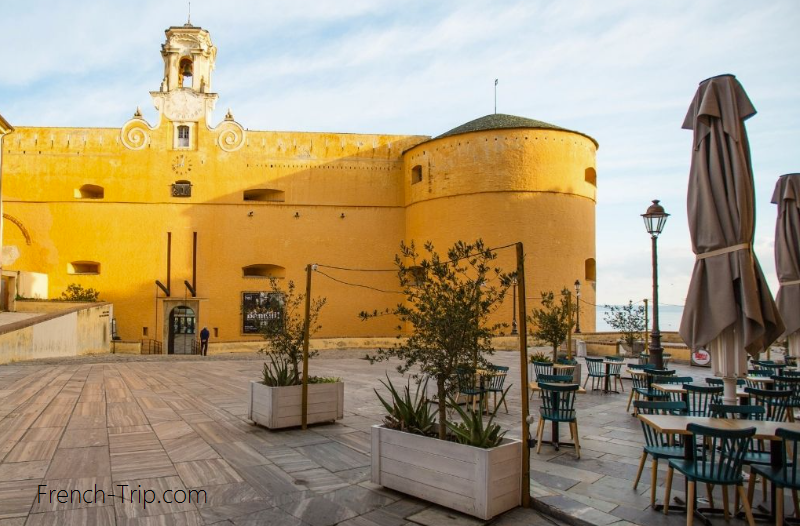
Musée de Bastia
The new museum was inaugurated on 25 June 2010. The collections, enriched in 1841 by the legacy of Giuseppe Sisco, the first surgeon of Pope Pius VII, then by part of the 100 Italian paintings bequeathed to the city in 1844 by Cardinal Fesch, through his nephew Joseph Bonaparte, Count of Survilliers (works based on the Mona Lisa), revolve around four themes: the birth and development of cities, the seat of power, the cultural centre and the governors’ palace. There are also temporary exhibitions in dedicated rooms. The Governors’ Garden, accessible through the museum, offers wonderful views.
Romieu Garden
Located below the Governors’ Palace and the Bastion Saint-Charles, the Romieu Garden descends in a series of terraces down to the sea. It was founded in 1874 and 1875 in a place where there were previously only rocky mounds and wild bushes. From the garden you come to the monumental Romieu staircase, which is the most beautiful decoration of the southern pier of the Old Harbour. It was built between 1871 and 1873 according to the plans of the Bastian architect Paul-Augustin Viale. This staircase, with its harmonious curves, decorated with supporting vases, a drainpipe, a niche with a statue and elegant wrought iron railings, connects the citadel area with the new pier.
Cathedral of Santa Maria de Bastia
The Cathedral of Sainte-Marie, constructed in 1495 and extensively renovated in the early 17th century, is situated at the heart of Bastia’s citadel. Behind the cathedral, you’ll find the richly adorned Chapel of Sainte-Croix, home to the Miraculous Christ, a revered figure discovered floating on water in 1428 by two fishermen. This cathedral is recognized as a Historical Monument.
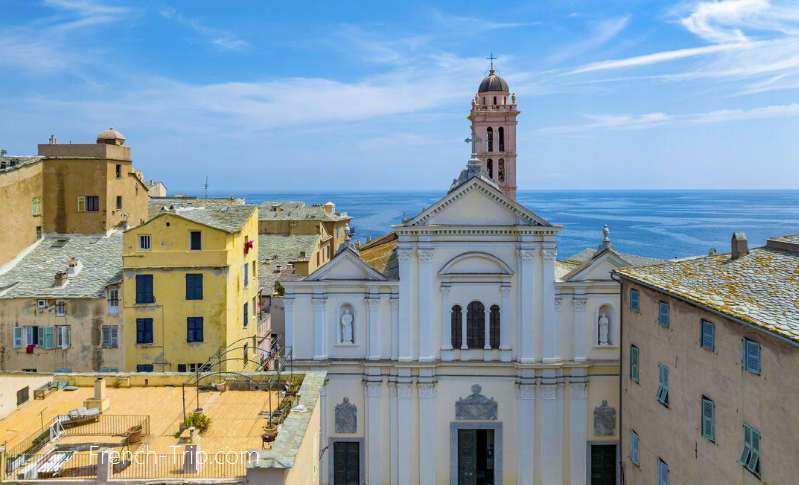
Church of Saint-Jean-Baptiste
One of Bastia’s most iconic landmarks, the Church of Saint-Jean-Baptiste was originally built in 1583 and is prominently located overlooking the Old Port. Due to its small size, it was replaced in the mid-18th century by a larger structure. The church features a grand classical façade, partially obscured by surrounding buildings, and an 18th-century Baroque interior, including notable elements such as an organ, an armchair, and paintings from Cardinal Fesch’s collection. It is also designated as a Historical Monument.
Rue Napoléon
Rue Napoléon, established in 2013, is Bastia’s only fully pedestrianized street, situated between Place Saint-Nicolas and the Old Port. This vibrant shopping area is home to the Oratory of the Brotherhood of Saint-Roch and the Oratory of the Immaculate Conception, adorned with a distinctive pebble mosaic. The street is lined with trendy boutiques and restaurants, making it a popular spot for both locals and visitors.
Oratoire de l’Immaculée Conception
Built in 1611 by the Brotherhood of the Immaculate Conception, the Oratory of the Immaculate Conception was renovated in 1763 and 1806. Notable for its 19th-century painted vault and velvet-covered walls, the oratory’s museum sacristy houses a rich collection of religious art from the 15th to 19th centuries. It is classified as a Historic Monument.
Terra Vecchia
Beyond the harbor, the Terra Vecchia district offers a charming stroll through narrow streets lined with medieval buildings. As you approach the Church of Saint-Jean-Baptiste, the streets narrow and the buildings grow taller, showcasing the area’s historical character.
Bastia New Town
Terra Nova, the newer section of Bastia, features broad boulevards and a range of shops. It boasts several impressive 19th-century buildings, including the classical-style Theatre and Palais de Justice. The city’s architectural history is evident in its many churches and chapels, with styles ranging from Baroque to Neoclassical. Notably, the Church of Saint-Jean-Baptiste, the largest church in Corsica, has 19th-century bell towers added later.
Place du Marché
Situated behind the Church of Saint-Jean-Baptiste, the Place du Marché is a lively square with numerous trees, restaurants, and impressive 19th-century mansions.
The Place du Marché hosts Bastia’s main market every weekend morning. On other days, there is a smaller market.
Place Saint Nicholas
To the north of the spacious Place Saint Nicholas, where Bastia’s tourist office is located, there are also various cafes and views of the sea, as well as a large statue of Napoleon and another underground car park. Although its large size and the number of parked cars make this square less attractive than the Place du Marché, a small tourist train departs from Place Saint-Nicolas and takes 45 minutes past Bastia’s main attractions.
The square is also home to the Casabianca submarine kiosk, a symbol of Corsican Resistance during WWII. Leaving Toulon harbour in November 1942, it sailed between the island and Algiers as part of the secret Pearl Harbor mission and achieved many military successes. The tower is now located on the base at the bottom of Place Saint-Nicolas, opposite the commercial port and the town hall.
On Sundays, the square hosts a flea market. Throughout the year, it hosts various events including summer concerts, a winter ice rink, and fairs such as the Salon du Chocolat in October.
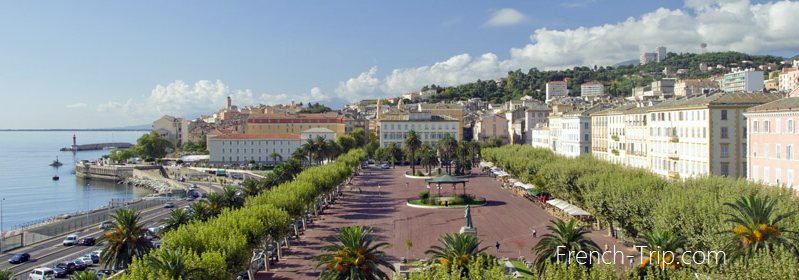
West of Place du Marché and Place de la République, Bastia’s main 19th-century boulevards are lined with shops and hotels.
Bastia attractions on the map:
Archives
Calendar
| M | T | W | T | F | S | S |
|---|---|---|---|---|---|---|
| 1 | 2 | 3 | 4 | 5 | 6 | 7 |
| 8 | 9 | 10 | 11 | 12 | 13 | 14 |
| 15 | 16 | 17 | 18 | 19 | 20 | 21 |
| 22 | 23 | 24 | 25 | 26 | 27 | 28 |
| 29 | 30 | 31 | ||||
